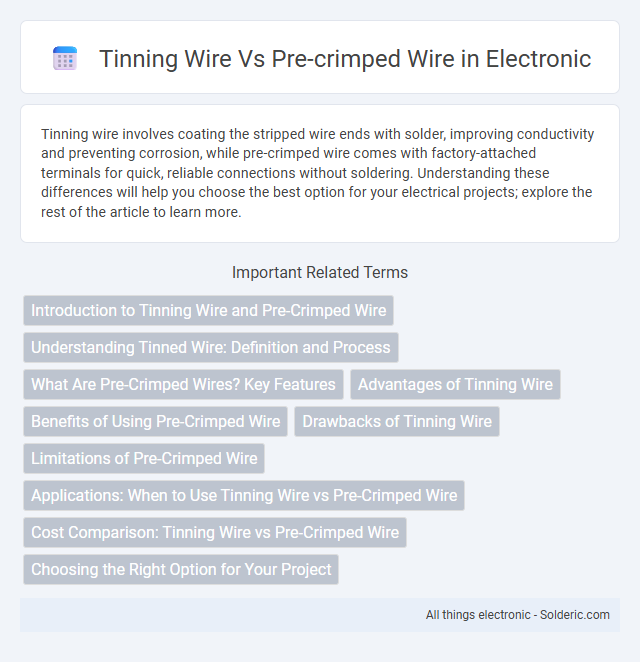Tinning wire involves coating the stripped wire ends with solder, improving conductivity and preventing corrosion, while pre-crimped wire comes with factory-attached terminals for quick, reliable connections without soldering. Understanding these differences will help you choose the best option for your electrical projects; explore the rest of the article to learn more.
Comparison Table
| Feature | Tinning Wire | Pre-Crimped Wire |
|---|---|---|
| Definition | Wire strands coated with solder to prevent fraying and corrosion. | Wire terminated with factory-crimped connectors for ready use. |
| Installation | Requires manual crimping and soldering during assembly. | Plug-and-play; no extra crimping or soldering needed. |
| Durability | Good resistance to corrosion with proper tinning. | High mechanical strength due to professional crimping. |
| Reliability | Dependent on quality of manual soldering and crimping. | Consistent and reliable electrical connections. |
| Flexibility | Offers flexibility before installation. | Less flexibility due to fixed terminal ends. |
| Cost | Generally lower upfront cost but higher labor cost. | Higher initial cost with labor savings. |
| Applications | Used in custom wiring and DIY projects. | Ideal for industrial, automotive, and mass production. |
Introduction to Tinning Wire and Pre-Crimped Wire
Tinning wire involves coating copper strands with a thin layer of solder to enhance corrosion resistance and improve electrical connectivity. Pre-crimped wire features factory-attached terminals, ensuring consistent and reliable mechanical and electrical connections. Both methods optimize wiring reliability in electrical assemblies, with tinning suited for custom connectors and pre-crimped wires ideal for rapid installation and standardized applications.
Understanding Tinned Wire: Definition and Process
Tinned wire features a thin layer of tin coating applied to the copper conductor, enhancing conductivity and protecting against corrosion in electrical applications. The tinning process involves cleaning the copper wire and dipping it into molten tin or applying solder paste, creating a durable, conductive surface that improves solderability and extends wire longevity. Understanding this process helps you choose the right wire for reliable connections, especially when comparing it to pre-crimped wires that come ready for immediate terminal attachment.
What Are Pre-Crimped Wires? Key Features
Pre-crimped wires are pre-assembled electrical cables with connectors already crimped onto the wire ends, ensuring consistent and reliable connections in industrial and automotive applications. Key features include reduced installation time, enhanced durability through professional-grade crimps, and improved electrical conductivity by minimizing signal loss. These wires also offer standardized quality control, reduce the risk of assembly errors, and support compatibility with various terminal types and connector housings.
Advantages of Tinning Wire
Tinning wire enhances solderability by providing a protective coating that prevents oxidation and improves electrical conductivity, ensuring reliable connections over time. It also offers flexibility in custom-length wiring and compatibility with various terminal types, reducing stocking costs. This process facilitates easier soldering, reduces the risk of wire strand fraying, and increases overall durability in electrical and electronic applications.
Benefits of Using Pre-Crimped Wire
Pre-crimped wire provides consistent and reliable electrical connections by factory-controlled crimping, reducing the risk of poor contact and signal loss common with manually tinned wire. Its time-saving nature increases assembly efficiency and ensures uniform quality across complex wiring harnesses. Using pre-crimped wire minimizes rework and maintenance costs, enhancing long-term system performance and safety.
Drawbacks of Tinning Wire
Tinning wire reduces flexibility and can cause the conductor to become brittle, increasing the risk of breakage during repeated bending or vibration. It also complicates proper insertion into connectors because excess solder may create uneven thickness, leading to poor electrical contact. For reliable connections, pre-crimped wire offers better durability and consistent performance, helping you avoid these drawbacks inherent in tinning.
Limitations of Pre-Crimped Wire
Pre-crimped wire offers quick and reliable connections but has limited flexibility in custom wire lengths and terminal types, restricting its adaptability in complex or dynamic wiring projects. The fixed terminal size and style can lead to compatibility issues with diverse connectors or equipment specifications. Additionally, pre-crimped wires may result in higher inventory costs due to the need for various pre-assembled configurations to cover different applications.
Applications: When to Use Tinning Wire vs Pre-Crimped Wire
Tinning wire is ideal for applications requiring enhanced corrosion resistance and better solder joint reliability, often used in electronics repair and prototyping where soldering is mandatory. Pre-crimped wire suits high-volume assembly and industrial automation, offering consistent mechanical strength and faster installation without soldering equipment. You should choose tinning wire when flexibility and solderability are crucial, while pre-crimped wire is preferred for rapid, reliable connections in manufacturing environments.
Cost Comparison: Tinning Wire vs Pre-Crimped Wire
Tinning wire typically offers a lower upfront cost due to its raw material form, making it ideal for bulk purchases and flexible applications. Pre-crimped wire incurs higher initial expenses because of added labor and manufacturing processes but can reduce installation time and potential rework costs. When evaluating total project costs, consider labor rates, volume, and application specifics to determine the most cost-efficient option between tinning and pre-crimped wires.
Choosing the Right Option for Your Project
Tinning wire involves coating the conductor with solder, enhancing corrosion resistance and improving solderability for custom wire assemblies. Pre-crimped wire offers a time-saving solution with factory-applied terminals ensuring consistent, reliable connections, ideal for high-volume or precision tasks. Your choice depends on whether flexibility in customization or efficiency and standardized quality are more critical for your project's requirements.
Tinning wire vs pre-crimped wire Infographic

 solderic.com
solderic.com